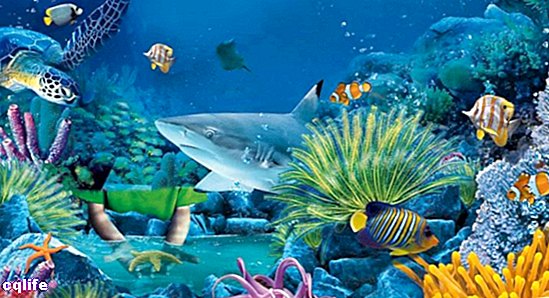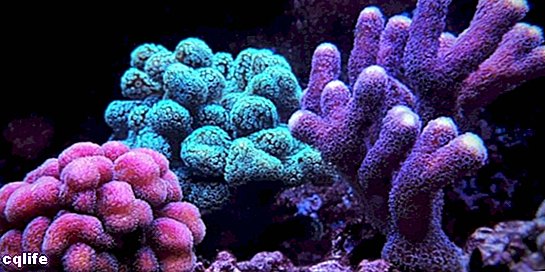- What is an aquatic ecosystem?
- Organisms of aquatic ecosystems
- Types of aquatic ecosystems
- Characteristics of an aquatic ecosystem
- Examples of aquatic ecosystem
We explain what aquatic ecosystems are, how they are classified and what their characteristics are. Also, examples of aquatic ecosystems.

What is an aquatic ecosystem?
An aquatic ecosystem is all that ecosystem that develops in a body of water of varying size and nature, which includes seas, lakes, rivers, swamps, streams, lagoons and shores. In them the nature of the Water, its cycles, as well as the organic content present in it, both from natural and sedimentary sources (the soils).
Organisms of aquatic ecosystems
Aquatic ecosystems contain three fundamental ecological categories of organisms: plankton, which floats freely; the nekton, which swims with intensity; and the benthos, which moves in the background.
- Plankton. It is usually made up of small or microscopic organisms that are relatively weak swimmers. Most of the plankton is carried adrift by currents and waves. Plankton is usually divided into two main categories:
- Phytoplankton. They are photosynthetic bacteria and free-floating algae, that is, producers that form the basis of most aquatic food webs.
- Zooplankton. They are non-photosynthetic organisms that include protozoa, crustaceans tiny and larval stages of many animals.
- Necton. They are larger organisms that actively swim, like fish, turtles Y Whales.
- Bentos. They are organisms that inhabit the bottom of the sea that fixate on a point (sponges, oysters and spider crabs), take refuge in the sand (many worms and echinoderms), or walk or swim on the surface (lobsters, larvae of aquatic insects and sea stars).
Types of aquatic ecosystems
Aquatic ecosystems are roughly divided into ecosystems maritime (those belonging to ocean and its coasts) and ecosystems of sweet water (rivers, lakes, lagoons and streams), because according to the physical and chemical characteristics of each one, they will have a fauna and Flora different, adapted as best as possible to vital conditions.
Marine ecosystems
Marine ecosystems are highly varied and rich in fauna and flora, in a wide range from microorganisms, mammals marine, fish, mollusks, even large predators and static and mobile plant forms. Let us remember that this is where the life at planet. The immense and complex marine environment is subdivided into several zones:
- Intertidal. It is the area where the sea connects with the mainland, either on the surface or underground. It is an area of much change and great movement Y erosion. High levels of light and nutrients, along with an abundance of oxygen, make the intertidal zone a biologically productive environment. Seaweed and Invertebrate animals.
- Ocean bottom. Also called a benthic environment, it is divided into zones according to its distance from the ground, the availability of light and the depth. Characterized by low temperatures and lower incidence of light, consists of sediments (mainly sand and mud) where many marine animals such as worms and clams are found. Benthic communities in shallow marine waters include seagrass beds, kelp forests (the largest known brown algae), and coral reefs. The abyssal zone is the part of the benthic environment that extends from a depth of 4000 to 6000 m. The hadal zone is the part of the benthic environment deeper than 6000 m.
- Open sea. Also called the pelagic environment, it is the most densely populated region with the largest temperatures, which gradually descend as you descend in height. It's divided in:
- The Neritic province. It consists of shallow waters that cover the continental shelf, that is, the ocean floor from the coast to a depth of 200 m. The organisms that live in the Neritic province are floaters or swimmers. Phytoplankton are abundant, particularly diatoms in colder waters and dinoflagellates in warmer waters. Zooplankton includes tiny crustaceans, jellyfish, protists; like foraminifera, and crab larvae, sea urchins, worms and crabs. Herring, sardines, squid, stingrays, whales, sharks, tuna, dolphins and toothed whales.
- The oceanic province. It constitutes most of the ocean and is the one that covers the deep sea basin, that is, the seabed at depths greater than 200 m. It is the largest marine environment and contains about 75% of the sea water. It is characterized by having cold temperatures, without sunlight, low presence of organic material (although it has a constant rain of waste from the upper layers), gigantic water pressures and a fauna adapted to these extreme conditions of darkness and lack of food, whose forms and survival mechanisms are usually striking or surprising.
Freshwater ecosystems
Freshwater ecosystems are subdivided according to water movements, into three types:
- Swamps and marshes (freshwater wetlands). They are terrestrial regions that are flooded during a good part of the year, and that can also face short periods of drought. They tend to promote the encounter of aquatic ecosystems with other terrestrial ones. They have characteristic soils and water-tolerant vegetation. The marshes are dominated by herbaceous plants and the swamps by woody trees or shrubs.
- Ponds, lakes and lagoons (lentic ecosystems). They are still waters or of little flow and are characterized by having a zoning. A large lake has three basic zones: the littoral zone (shallow water along the shore), the limnetic zone (it is the open water beyond the littoral zone) and the deep zone (below the limnetic zone. Smaller lakes and ponds often lack the deep zone). They contain more organic matter in suspension in the water. Some animals of the littoral zone are frogs and their tadpoles, turtles, worms, crayfish and other crustaceans, insect larvae and many fish such as perch and carp. The main organisms in the limnetic zone are microscopic phytoplankton and zooplankton. Larger fish are also in the limnetic zone, although they can visit the littoral zone to feed and reproduce.
- Streams and rivers (lotic ecosystems). They are running water systems such as rivers, streams, streams, etc. The nature of these ecosystems changes a lot from its source (the place where it begins) to its mouth (where it empties into another body of water). The sources are usually shallow, sharp, cold, fast-flowing, and fairly oxygenated. In contrast, downstream currents are broader and deeper, turbid (that is, they contain suspended particles), they are not as cold, they run slow and they are less oxygenated. They present a greater coexistence of species, among fish, reptiles, amphibians, birds, etc.
Characteristics of an aquatic ecosystem

Aquatic ecosystems are numerous and abundant in life, so they tend to present complex Trophic chains from animals adapted to the specific conditions of the water: its salinity, its currents, etc. In the case of rivers, much will depend on the terrestrial elements carried or dissolved by the current, as well as the presence or absence of mineral or organic matter in the soils that it runs through.
With the exception of amphibians and aquatic reptiles, many of which thrive in the water but return to land to lay eggs (or vice versa), most of the animals in these ecosystems are adapted to permanent immersion in water, for what they depend on their biotic balance.
The same happens with the flora, mostly composed of algae and other photosynthetic forms that abound in the most superficial regions, where there is more sunlight. In the swamps, on the other hand, where the water is dark and full of organic debris, the organisms adapt to the low concentration of oxygen.
Examples of aquatic ecosystem
Some examples of aquatic ecosystems are:
- Mangroves They are characterized by their dense and dark waters, with little movement. Their soils are usually clayey and covered with decomposing organic matter. Small fish and amphibian life forms predominate, as well as mangroves, trees whose characteristic roots stick out of the water.
- Cost line. The coasts of the warm seas are particularly abundant in animal and vegetal life, and for this reason they are the most common fishing regions. Coral reefs, schools of fish and various food chains make up its blue waters.
- Ponds Characterized by water with very little movement and a high presence of organic matter from neighboring trees, they tend to host a huge variety of microscopic life, as well as small fish and insects.
- Polar ocean The icy waters of the poles, abundant in icebergs and frozen land, also harbor minimal flora (generally bacterial), and different animals adapted to intense cold, such as aquatic mammals and cold-water fish.
- Coral reefs. They are formed as coral organisms (scleractinian cnidarians) secrete calcium carbonate (CaCO3). They are found in warm marine waters (whose temperature is usually greater than 21 ° C), shallow and with low content of nutrients. Coral reef ecosystems are the most diverse of all marine ecosystems and contain hundreds or even thousands of species of fish and invertebrates, such as giant clams, sea urchins, starfish, sponges, sea fans, and shrimp.
